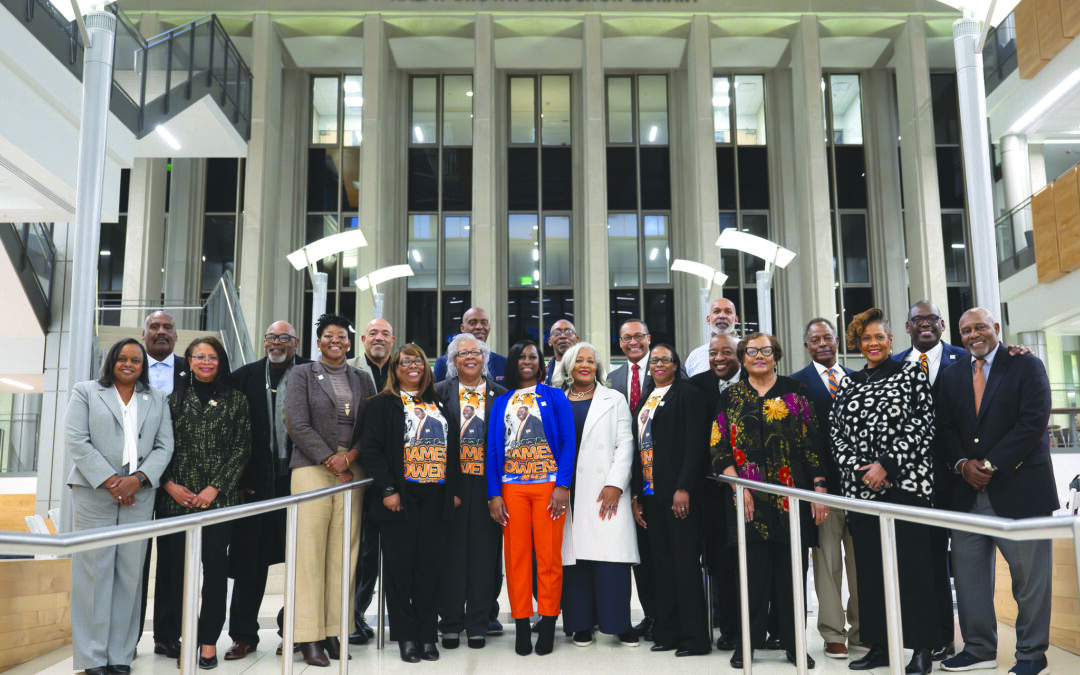Honoring the legacy of Harold Franklin and other ‘first’ students
CONTRIBUTED BY AUBURN UNIVERSITY NEWS | WRITTEN BY AMY WEAVER
AUBURN — The Samford Hall bell tolled precisely 10 times at 2:20 p.m. on Jan. 4.
The moment may have confused those not aware of the significance, but it made sense for a small group gathered in the circular brick courtyard near the desegregation marker.
Auburn University President Christopher B. Roberts told the group it was meant to signify the 10 steps Harold A. Franklin took on that day in 1964 to enter the university library and register for classes, officially integrating the university.
Those same steps served as the backdrop for a commemorative event on Jan. 9. A large group of invited guests, university officials, alumni, students, faculty and staff filled in the atrium of the Mell Classroom Building. The group also included a number of Auburn’s “firsts,” including the families of Harold Franklin, Josetta Brittain Matthews and James Owens.
“It is so fitting that we gather today at the very location where the late Dr. Harold Franklin literally took the first steps toward integration at Auburn 60 years ago,” said Quentin Riggins, an Auburn alumnus and president pro tempore of the Auburn Board of Trustees. “It was inside the Ralph Brown Draughon Library right behind me where everything started, and it is quite a surreal moment to stand in this spot and realize all that has occurred since that important day on Jan. 4, 1964.”
Riggins shared the podium with Roberts; Taffye Benson Clayton, vice president and associate provost for inclusion and diversity; actor and alumnus Thom Gossom Jr.; Trustee Elizabeth Huntley; and Vini Nathan, provost and senior vice president for academic affairs. Each shared stories about Franklin and his legacy.
STARTING A LEGACY
Franklin’s walk on that day set in motion a ripple effect.
“Auburn is a better institution for Harold Franklin’s bravery,” said Clayton.
In 2021, the university commemorated Franklin’s courage with a bronze plaque and a brick courtyard adjacent to the library. At the dedication ceremony, Roberts said his friend and Auburn engineering alumnus Kenneth Kelly referred to Franklin as a “proud man who never asked for anything but opportunity.”
Franklin, who was a U.S. Air Force veteran, husband and father, was mature enough to know “his actions were going to benefit others more than it would benefit himself,” added Kelly.
And benefit others he did.
Two years after Franklin’s integration, Josetta Brittain Matthews became the first African American to graduate. She would then join the Auburn faculty and earn a doctorate, becoming the first person of color to do both.
Samuel Pettijohn Jr. followed, becoming the first African American undergraduate to graduate from Auburn and its first African American ROTC graduate. Yvonne Lampkin Fowlkes was the first African American woman to earn an undergraduate degree.
In the presiding decades, others continued to follow in Franklin’s legacy, including Riggins, who became the first African American to serve as president pro tempore of the Board of Trustees last June, and Thom Gossom Jr., the first African American to walk on the Auburn football team, earn a scholarship and graduate.
ONE MAN’S JOURNEY
Gossom said he was attracted to Auburn for a number of reasons, one being Franklin. Six years after his integration, Gossom said he wrote down a New Year’s resolution: “to attend and play football at Auburn University.” That piece of paper remained in Gossom’s wallet until 1975 when he graduated from Auburn.
The 1960s were tumultuous times, especially in the South, with Alabama Gov. George Wallace standing in front of the schoolhouse door to prevent the integration of the University of Alabama and Martin Luther King Jr. trying to unify a broken nation with his eloquent words in front of the Lincoln Memorial.
Gossom said he would be one of less than 100 African Americans to enter Auburn in its first five years of integration. His parents valued education, but he didn’t know anyone at Auburn or who graduated from there. He didn’t know any of the football coaches, and they didn’t know him.
But the coaches welcomed Gossom.
“Football is a macho thing,” he said. “When it was time to fight, I fought. When I needed to make friends, I made friends.”
In 10 months, Auburn awarded Gossom a full athletic scholarship. He was a starter for the next three years. He saw more black athletes join the team. Win or lose, they all valued Auburn.
“It all came down to that core belief in the power of education and what it can do,” said Gossom. “An Auburn education showed us all that we could not only uplift ourselves, change our own circumstances, but also lead the way to a brighter future for generations to come.”
FOR FUTURE GENERATIONS
Huntley reminded everyone of Franklin’s “tenacity, perseverance and his Auburn spirit that was never afraid.”
“His legacy is one firmly rooted in doing the right thing and, in turn, creating opportunity for others,” she said.
In December 2020, Franklin returned to Auburn to participate in fall commencement. He was presented with a copy of the Auburn Creed — like every student upon graduation — and participated in the ceremonial hooding of Auburn’s first female African American doctoral graduate in the Department of History.
Huntley called it a full-circle moment. Franklin would have earned that same degree had he been given the chance to defend his thesis properly back in the day. Auburn gave him that long-overdue opportunity in February 2020.
Auburn continues to reflect on the legacy of Franklin and the others who followed, like Matthews and Bessie Mae Holloway, the first African American to serve on the Board of Trustees. In 2021, Auburn renamed two of the residence halls in the Village after these trailblazing ladies. A year later, Auburn unveiled the National Pan-Hellenic Council Legacy Plaza, recognizing the history, legacy and cultural impact of Black Greek organizations on campus.
“The NPHC Legacy Plaza is a testament to the university’s charge to create a more inclusive environment and the student body’s desire to ensure that their peers are equally represented,” said Huntley.
Auburn also renamed its student center after Harold Melton, its first African American Student Government Association president. Huntley’s own daughter, Ada Ruth, would follow in Melton’s footsteps, serving in 2020 as the first African American female SGA president.
Nathan felt “a debt of honor” to Franklin and his family. Some say Franklin was lucky to pick Auburn, but Nathan says, “Auburn was even luckier that he chose us to pursue his education.”
“I’m thankful that we have an institution that cares,” said Hailey Clayton, vice president of the Black Student Union. “We’re acknowledging that someone believed in Auburn, even when Auburn didn’t believe in them. And it shows present-day Black students and students of color, but all students that Auburn does believe in you now. If you believe in Auburn, it will believe in you.”


